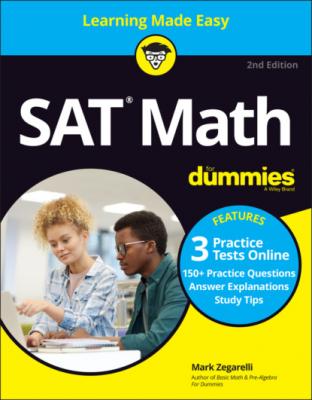SAT Math For Dummies with Online Practice. Mark Zegarelli
Чтение книги онлайн.
Читать онлайн книгу SAT Math For Dummies with Online Practice - Mark Zegarelli страница 14

Integers
The next set of numbers are the integers, which include the natural numbers, 0, and the negative whole numbers:
The set of integers is closed under addition, subtraction, and multiplication, because when you apply any of these operations to any pair of integers, the result is an integer. However, the integers aren’t closed under division, because when you divide a pair of integers, the result isn’t always an integer. For example:
Rational numbers
The rational numbers are the set of all numbers that can be expressed as fractions with integers in both the numerator and denominator. For example:
|
|
|
|
|
|
As you can see, the set of rational numbers includes all the integers, because every integer can be expressed as the numerator of a fraction with 1 in the denominator.
The set of rational numbers is closed under addition, subtraction, multiplication, and division.
Points on the number line that cannot be expressed as fractions — such as
Real numbers
The real numbers are the combined set of both rational and irrational numbers. This set includes every point on the number line.
Like the rational numbers, the set of real numbers is closed under the basic four operations. However, the set of real numbers isn’t closed under the operation of taking a square root, because the square root of a negative number isn’t a real number. For example:
|
|
|
The square root of a negative number is called an imaginary number — that is, a real number multiplied by
Only a few SAT questions include imaginary numbers. You learn more about imaginary numbers in Chapter 12, where I focus on the roots of quadratic functions, and in Chapter 15, where I discuss operations with imaginary numbers.
Complex numbers
The complex numbers are the set of all numbers of the form
The complex numbers include the set of real numbers, the set of imaginary numbers, and other values. Like the rational numbers and real numbers, the complex numbers are closed under the basic four operations. They’re also closed under square roots and a variety of other operations.
Very few questions on the SAT require knowledge of the complex numbers. I discuss the specific points you need to know about them in Chapters 12 and 15.
Fractions, Ratios, Decimals, and Percentages
Fractions, ratios, decimals, and percentages are four complementary ways of describing rational numbers — that is, the values that lie between the integers on the number line. In this section, you get a quick review of how to work with these important mathematical values.
Review of fractions and ratios
A fraction is composed of two integers: a numerator (top number) divided by a denominator (bottom number). For example:
|
|
|
|
|
The reciprocal (or inverse) of a fraction is the result when you exchange the numerator and denominator. For example:
|
|
|
|
|
Converting between improper fractions and mixed numbers
A proper fraction has a numerator that’s less than its denominator. In contrast, an improper fraction has a numerator that’s greater than or equal to its denominator.
Improper fractions can be awkward, because in many real-world cases, an improper fraction